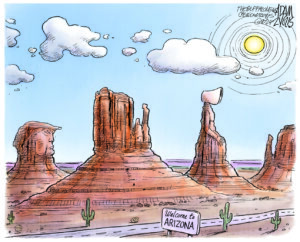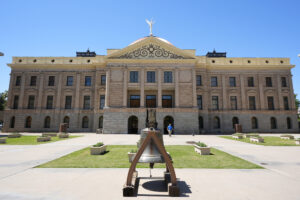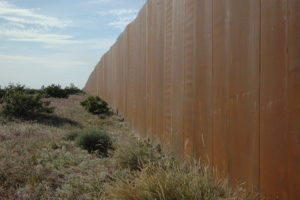Illegal Immigration Isn’t the Only Thing Infuriating Arizona Residents
At midnight on July 15, Arizona’s Department of Public Safety pulled the plug on dozens of speed cameras that criss-crossed state highways, part of a widely loathed program to catch traffic violators and control erratic driving. This at a time when every other government agency around the nation is steadily adopting as many enhanced security technologies as possible.
Few stories about the state of Arizona could possibly command more attention right now than its passage of a bill that directs police officers to determine the immigration status of people they come into contact with and suspect of being in the country illegally.
While Americans were riveted by debate over the law, however, something else occurred there recently that’s nothing short of remarkable, something that also turned out to be fatally tragic for one man. And it could have implications for the former governor of Arizona, called upon by Barack Obama at the beginning of his term to take over the Department of Homeland Security.
At midnight on July 15, Arizona’s Department of Public Safety pulled the plug on dozens of speed cameras that criss-crossed state highways, part of a widely loathed program to catch traffic violators and control erratic driving. This at a time when every other government agency around the nation is steadily adopting as many enhanced security technologies as possible.
Outrage among residents over the cameras grew so severe that a technician who worked for the contractor hired to maintain the devices was shot to death last year. Other less-violent local tales of defiance include covering the cameras with boxes and Post-it Notes, disarming them with an axe, leaving tickets unpaid, or in the case of one driver, donning a monkey mask to foil attempts at identification. A politician from the area even said surveillance trends like speed cameras are an ominous sign that Obama and the federal government may eventually track drivers with microchips.
Janet Napolitano, one-time governor of the state, “famously” declared the camera system would generate $90 million in needed revenue from citations during its first year, according to the Arizona Republic. The total instead came in at $78 million after almost two years, a figure that still arguably makes the program a cash cow but nonetheless was cited as another reason for abandoning it.
Aggravation some Arizona residents expressed over the intrusive nature of the cameras poses an intriguing dilemma for Washington where Napolitano now leads a sprawling homeland security bureaucracy that probably does more to represent the idea of domestic surveillance – good or bad – than any other federal agency.
Ex-GOP state Rep. Sam Crump, who’s now making a bid for Congress, applauded Arizona’s move to end its speed-camera program calling it an abusive use of the technology and suggesting it would result in more spying from the government. “I can see the Obama administration putting a chip in every car and saying, ‘We’ll issue a ticket,’” if you break the law, the Republic quoted him as saying.
Redflex Traffic Systems, the company in charge of operating the cameras, warned gravely – and perhaps somewhat predictably – that if they were taken down, a segment of drivers would endanger the lives of others by becoming bold and reckless. The recent move doesn’t impact similar speed-camera systems maintained by local governments in Arizona since this case only involves a state-run network. But there have been attempts through a ballot initiative and legislation to ban them completely from state highways.
Instances exist elsewhere of towns fighting back against public-safety projects viewed as a threat to privacy. Local leaders in the tiny fishing village of Dillingham, Ala., used $200,000 in federal homeland security grants to blanket parts of the town with 80 surveillance cameras. Some residents complained about them so relentlessly that Dillingham’s mayor eventually resigned due to criticism.
Meanwhile, police in other cities across the country are continuing years-long campaigns to expand the use of such cameras, much of it fueled by anti-terrorism funds handed out by Washington. Or they’re deploying more sophisticated technologies that actually are capable of registering the GPS locations of innocent and guilty motorists alike, namely license-plate scanners.
New York City is among the leaders with its “ring of steel,” a plan announced in 2006 to install 3,000 public and private cameras alongside dozens of license-plates readers to guard Lower Manhattan against terrorists. Yet residents in the Big Apple learned recently that hundreds of cameras controlled by the city’s public transit authority didn’t actually work.
Police in Pittsburgh, on the other hand, say camera footage helped them identify two teenaged suspects allegedly behind the killing of a retired firefighter. Shortly afterward the mayor announced he wanted to use $12 million in Recovery Act funding for a project that would include 200 more cameras.
Surveillance devices can also aid in enforcing better conduct among public employees. Los Angeles installed them in the control cabs of metro trains to observe engineers after one operator, reportedly distracted by text messaging, was blamed in part for the gruesome 2008 Chatsworth accident that killed 25 people.
GOP Congressman Jeff Flake of Arizona blasts a $200,000 homeland security grant as wasteful. A tiny fishing village in Alaska used it to purchase surveillance cameras.
Independent journalism is under threat and overshadowed by heavily funded mainstream media.
You can help level the playing field. Become a member.
Your tax-deductible contribution keeps us digging beneath the headlines to give you thought-provoking, investigative reporting and analysis that unearths what's really happening- without compromise.
Give today to support our courageous, independent journalists.






You need to be a supporter to comment.
There are currently no responses to this article.
Be the first to respond.